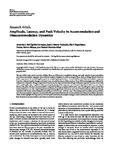Amplitude, Latency, and Peak Velocity in Accommodation and Disaccommodation Dynamics.
| dc.contributor.author | Del Águila-Carrasco, AJ | en |
| dc.contributor.author | Esteve-Taboada, JJ | en |
| dc.contributor.author | Papadatou, E | en |
| dc.contributor.author | Ferrer-Blasco, T | en |
| dc.contributor.author | Montés-Micó, R | en |
| dc.date.accessioned | 2018-09-20T17:46:30Z | |
| dc.date.available | 2018-09-20T17:46:30Z | |
| dc.date.issued | 2017 | en |
| dc.identifier.uri | http://hdl.handle.net/10026.1/12397 | |
| dc.description.abstract |
The aim of this work was to ascertain whether there are differences in amplitude, latency, and peak velocity of accommodation and disaccommodation responses when different analysis strategies are used to compute them, such as fitting different functions to the responses or for smoothing them prior to computing the parameters. Accommodation and disaccommodation responses from four subjects to pulse changes in demand were recorded by means of aberrometry. Three different strategies were followed to analyze such responses: fitting an exponential function to the experimental data; fitting a Boltzmann sigmoid function to the data; and smoothing the data. Amplitude, latency, and peak velocity of the responses were extracted. Significant differences were found between the peak velocity in accommodation computed by fitting an exponential function and smoothing the experimental data (mean difference 2.36 D/s). Regarding disaccommodation, significant differences were found between latency and peak velocity, calculated with the two same strategies (mean difference of 0.15 s and -3.56 D/s, resp.). The strategy used to analyze accommodation and disaccommodation responses seems to affect the parameters that describe accommodation and disaccommodation dynamics. These results highlight the importance of choosing the most adequate analysis strategy in each individual to obtain the parameters that characterize accommodation and disaccommodation dynamics. | en |
| dc.format.extent | 2735969 - ? | en |
| dc.language | eng | en |
| dc.language.iso | eng | en |
| dc.subject | Accommodation, Ocular | en |
| dc.subject | Adult | en |
| dc.subject | Eye | en |
| dc.subject | Humans | en |
| dc.subject | Reaction Time | en |
| dc.subject | Refraction, Ocular | en |
| dc.title | Amplitude, Latency, and Peak Velocity in Accommodation and Disaccommodation Dynamics. | en |
| dc.type | Journal Article | |
| plymouth.author-url | https://www.ncbi.nlm.nih.gov/pubmed/29226128 | en |
| plymouth.volume | 2017 | en |
| plymouth.publication-status | Published | en |
| plymouth.journal | Biomed Res Int | en |
| dc.identifier.doi | 10.1155/2017/2735969 | en |
| plymouth.organisational-group | /Plymouth | |
| plymouth.organisational-group | /Plymouth/Faculty of Health | |
| plymouth.organisational-group | /Plymouth/Faculty of Health/School of Health Professions | |
| plymouth.organisational-group | /Plymouth/REF 2021 Researchers by UoA | |
| plymouth.organisational-group | /Plymouth/REF 2021 Researchers by UoA/UoA03 Allied Health Professions, Dentistry, Nursing and Pharmacy | |
| plymouth.organisational-group | /Plymouth/Users by role | |
| plymouth.organisational-group | /Plymouth/Users by role/Academics | |
| dc.publisher.place | United States | en |
| dcterms.dateAccepted | 2017-10-02 | en |
| dc.identifier.eissn | 2314-6141 | en |
| dc.rights.embargoperiod | Not known | en |
| rioxxterms.versionofrecord | 10.1155/2017/2735969 | en |
| rioxxterms.licenseref.uri | http://www.rioxx.net/licenses/all-rights-reserved | en |
| rioxxterms.licenseref.startdate | 2017 | en |
| rioxxterms.type | Journal Article/Review | en |


